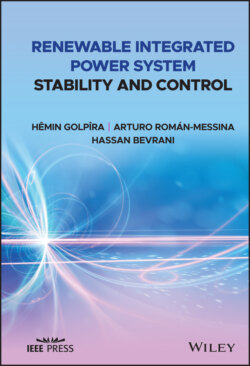Читать книгу Renewable Integrated Power System Stability and Control - Hassan Bevrani - Страница 22
1.4 Dynamics Modeling and Parameters Estimation
ОглавлениеFrom a system dynamic point of view, the bulk generating units, due to their high inertia, provide a long time constant; such that the rotor speed and thus the grid frequency cannot alter suddenly, while the load changes. Hence, the total rotating mass enhances the dynamic stability. In future, a significant share of DGs/RESs/MGs in the electric power grids is expected. This increases the total system generation power, while does not contribute to the system rotational inertia. System dynamics are faster in power systems with low rotational inertia, making control and power system operation more challenging [32].
A complete understanding of reliability considerations via effective modeling/aggregation techniques is vital to identify a variety of ways that power grids can accommodate the large‐scale integration of the distributed micro‐sources in future. An accurate dynamic model is needed for the stability analysis and control synthesis in a grid with a high degree of DGs/RESs penetration. A proper dynamic modeling and aggregation of the DGs/RESs and MGs, for performance and stability studies, is a key issue to understand the dynamic impact of distributed microsources and simulate their functions in new environment.
The power system is a nonlinear multivariable time‐varying system. It is represented by a nonlinear set of equations for the generators (swing equations), for the transmission lines and for the loads, which for a typical power system has a few hundreds of states. For the control design purpose, usually a reduced‐order linearized model around an operating point is used and it is assumed that all system parameters are known and time‐invariant. These assumptions, however, are not valid in a real power system with dominated DGs/RESs/MGs. The main dynamic modes of the system are varying stochastically during a day because of the variation of load and aggregated inertia. The dynamic modes will change more significantly by integration of new RESs into the power system (e.g. because of long‐term variation of the mean value of the aggregated inertia). Therefore, a fixed linearized time‐invariant model will not represent correctly the behavior of the power system.
The frequency response of the system can be identified offline/online using the data for different load and generation configurations (when the share of DGs/RESs is increased) and saved in a database for the models. The small variation of the system (originated from measurement noise, load variation, and system nonlinearity) will be modeled by frequency domain uncertainty. The long‐term effect of change in system inertia can be considered by identifying several frequency‐domain models for different levels of RES penetration. One can represent this model's database by an LPV model [116]. It should be mentioned that the model of the power system for the frequency, voltage, and rotor angle is different because they have different inputs and outputs and scheduling parameters.
